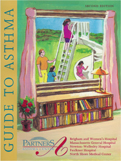Guide to Asthma
Lesson #7: What to do for an asthma attack: Your asthma Action Plan
One of the major reasons for learning more about asthma — and so, one of the purposes of this Asthma Guide — is to help you make good decisions if and when you suffer an asthma attack. If you find yourself having trouble breathing, perhaps gasping to catch your breath, the worst thing that you can do is to panic. Panic only makes it harder to breathe and more difficult to make smart choices. The best thing to do is take calm action to restore your breathing to normal.
Begin by considering in advance what you would do if faced with an asthma attack. Later in this Asthma Guide, you will have a chance to practice your decision-making on some made-up case examples. It is also a good idea to discuss your plan of action with your doctor and then to write out you asthma Action Plan. Keep your written Action Plan some place handy.
Based on what you have learned about asthma from the previous sections of this Guide, together with your own experiences, you are ready to plan a strategy for handling asthma attacks. Always remember that you need not manage your care alone. Friends and family may be near to help. Medical advice from your doctor or an associate is only a phone call away. If nothing else seems to be working, you can always summon emergency help by dialing "911" on your telephone.
The first step to relieve an asthma attack is to use your quick-acting bronchodilator (such as albuterol). The usual dose is 2 puffs, breathed slowly and deeply. In a sudden severe crisis of breathing, you can safely use as many as 4 puffs at a time. Under normal circumstances, it is usually recommended that you use your quick-relief bronchodilator no more than 4 times a day. To treat an asthma attack, however, you can safely use it as often as every 20 minutes for as long as 2 hours, if needed. If available, a compressor with nebulizer can be used in the same way, every 20 minutes for several doses. The major side-effects to anticipate are a jittery feeling and racing of the heart.
How best to deal with an asthma attack depends in part on how bad the attack is. Sometimes you can recognize a severe attack based on how you feel. You are having a severe attack if you have shortness of breath walking slowly on level ground, if your speaking is interrupted to catch your breath, if you are perspiring and can’t lie down because of difficulty breathing. At other times you may have severe narrowing of your breathing tubes but be unable to detect it based on how you feel — or you may deny to yourself just how bad it really is.
A peak flow meter is very useful in this situation. With it you can clarify how severe your asthma attack is, and you can measure whether you are getting better with treatment. If your peak flow is less than half of your best value, you are having a severe attack. For most persons, a peak flow of less than 200 liters per minute indicates a severe attack.
The quick-relief bronchodilators treat only part of an asthma attack, the part due to constriction of the muscles surrounding the bronchial tubes. The other part, the swelling of the walls of the bronchial tubes and over-production of mucus, requires the anti-inflammatory corticosteroids for treatment.
For an attack that is relatively mild and getting better with the quick-relief bronchodilator, you can take the corticosteroid medication by inhalation. Examples (by brand name) are Aerobid®, Azmacort®, Beclovent®, Flovent®, Pulmicort®, and Vanceril®). If you already use one of these medications every day as your preventer medicine, double your daily dose (take twice as many puffs as usual) during an attack.
For a severe attack, you will need to take prescription corticosteroid tablets, such as prednisone or Medrol®. A typical starting dose is 30-60 milligrams. The corticosteroid tablets usually take 6 or more hours to take effect. You will need to continue to use your quick-relief bronchodilator in the meantime, as often as every hour, if needed.
Your doctor may want you to have corticosteroid tablets available at home to use in the event of a severe asthma attack. Or your doctor may call your pharmacy with a prescription when you need one. In either case, be sure to keep your doctor informed if you are having serious difficulty with your breathing.
Severe asthma attacks can be dangerous. If you are not getting better despite following your asthma Action Plan, get help immediately.

